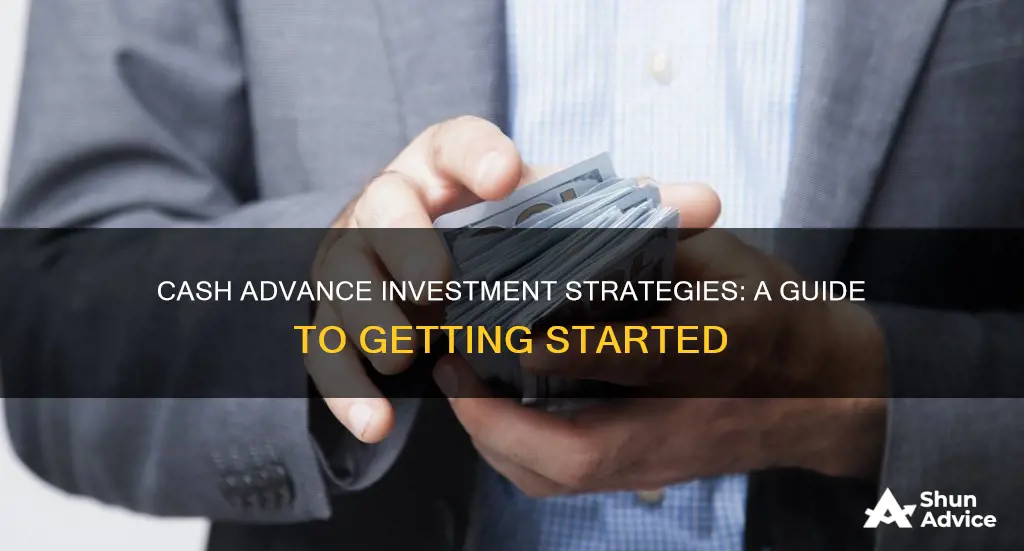
Cash advances are a quick and convenient way to get cash fast, but they come with high fees and interest rates. A cash advance is a short-term loan offered by a credit card issuer, allowing cardholders to borrow money against their credit line. The amount borrowed is then added to their credit card balance, which must be repaid in full. Cash advances can be accessed via an ATM, in person at a bank, or by using a convenience check. While they are an easy solution for emergency funding, there are less expensive alternatives available, such as personal loans or borrowing from friends and family.
| Characteristics | Values |
|---|---|
| Definition | A short-term loan from a bank, alternative lender, or credit card issuer. |
| Interest Rates | Typically high, and accrue immediately. |
| Fees | Typically 3-5% of the total amount, plus ATM fees. |
| Credit Score Impact | No direct impact, but can affect credit utilization ratio and lead to higher interest charges. |
| Alternatives | Borrowing from family/friends, personal loans, payday loans, overdrafts, early CD withdrawals. |
What You'll Learn

How to get a cash advance from a credit card
A cash advance is a short-term loan offered by your credit card issuer. When you take out a cash advance, you're borrowing money against your card's line of credit. Cash advances are easy to get but come with steep interest rates and fees, so they should only be used in emergencies.
At an ATM
If you have a PIN for your credit card, you can go to an ATM and get a cash advance. If you don't have a PIN, you can request one from your card issuer. Note that there may be daily withdrawal limits and fees similar to those imposed on checking accounts.
In Person
Visit your bank or credit union and request a cash advance with your credit card. You may be subject to daily withdrawal limits and fees.
Convenience Check
Your credit card issuer may provide you with convenience checks linked to your card account. You can fill out one of these checks and name yourself as the payee to get a cash advance. Then, you can cash or deposit it at your bank or another financial institution. Be sure to read the terms and conditions related to using convenience checks before choosing this option.
Before getting a cash advance, it's important to understand the costs involved. Cash advances typically come with higher interest rates and fees than regular purchases, and interest starts accruing right away. There may also be cash advance fees, ATM fees, and other charges.
Investing Excess Cash: Strategies for Smart Financial Planning
You may want to see also

Cash advance fees and interest rates
Cash advances are an expensive way to access cash, with high fees and interest rates. It's important to understand the costs associated with them before taking one out. Here are the fees and interest rates you can expect from a cash advance:
Cash Advance APR
The interest rate charged on cash advances is typically higher than the rate for purchases. For example, the Citi Double Cash® Card has a variable APR of 18.49% - 28.49% on purchases, but a 29.74% variable APR for cash advances. This higher APR can result in significant interest charges over time.
Cash Advance Fee
In addition to the high APR, credit card companies often charge a cash advance fee, typically ranging from 3% to 5% of the total amount of each cash advance. For instance, a $250 cash advance with a 5% fee will cost you $12.50. This fee is added to your card balance, and interest starts accruing immediately.
ATM or Bank Fee
If you use an ATM or visit a bank to obtain a cash advance, you may be charged an additional fee. These fees are similar to those imposed on checking accounts for ATM withdrawals or other transactions.
No Grace Period
Unlike purchases made with your credit card, cash advances do not benefit from a grace period. This means that interest starts accruing from the date you withdraw the cash advance, with no interest-free period.
Separate Credit Limit
Cash advances often have a separate credit limit that is a portion of your overall credit limit. This limit is typically capped at a percentage of your card's total credit limit. For example, if your credit limit is $10,000, your cash advance limit might be $3,000.
Due to the high fees and interest rates associated with cash advances, it is recommended to explore alternative options for obtaining cash, such as personal loans or borrowing from friends and family.
Understanding DCF Methods for Analyzing Investment Decisions
You may want to see also

How to pay off a cash advance
A cash advance is a way to obtain immediate funds through your credit card. It is essentially a short-term loan from your card issuer, and it can be convenient when you need money in a pinch. However, it is also a very expensive option. Here are some tips on how to pay off a cash advance:
- Understand the costs: Cash advances usually come with significant fees and interest rates. There is typically a transaction fee of around 3-5% and interest starts accruing immediately, with no grace period. The APR for cash advances is also often higher than for regular purchases, so it's important to understand the total cost before taking out a cash advance.
- Borrow as little as possible: To minimise costs, borrow only what you absolutely need. The smaller the cash advance amount, the less you'll have to pay in fees and interest.
- Repay as soon as possible: Start repaying the cash advance as soon as you can, ideally within days instead of weeks. The longer you take to repay, the more interest will accrue. Make it a priority to repay the cash advance before it accumulates interest for months.
- Pay more than the minimum: Your cash advance balance is separate from your purchase balance, and the minimum payment amount can be applied to either. By paying more than the minimum, you can ensure that the excess amount is applied to the balance with the highest interest rate, which is likely to be your cash advance.
- Consider alternatives: Before taking out a cash advance, explore other options such as using your credit card for purchases, low-interest personal loans, or borrowing from family or friends. These alternatives may be more financially prudent than a cash advance.
QuickBooks: Entering Invested Cash the Right Way
You may want to see also

Alternatives to a cash advance
While a cash advance may seem like a quick and easy way to get cash fast, it can be costly. Before taking out a cash advance, it is important to familiarize yourself with the terms and fees involved. There are several alternatives to cash advances that may be more cost-effective and have better terms. Here are some options to consider:
- Borrow from family or friends: Asking family or friends for a loan can be a cost-effective way to get the cash you need. It is important to create a repayment plan to maintain a good relationship.
- Take out a personal loan: Personal loans usually offer better terms than a cash advance, and you can access more cash if you have good credit. With a personal loan, you can usually pay back the loan at a fixed interest rate that is much lower than the APR charged by credit card issuers.
- Promotional offers from your card issuer: Some credit card issuers offer cheaper ways to access your credit line, such as the option to turn your available credit into an installment loan without a new loan application. While you will still be charged interest, the rate may be more reasonable.
- Overdraft on your checking account: While this option may incur a fee, it can provide short-term funds if you have authorized your bank to allow withdrawals even when your account balance is negative. Be careful, as some banks also charge extended overdraft fees.
- Early withdrawal from a certificate of deposit (CD): This option may be suitable if you need money right away, but keep in mind that CDs are meant for long-term deposits, and you may face early withdrawal penalties.
- Payday alternative loan (PAL): A PAL is an inexpensive short-term loan regulated by the National Credit Union Administration (NCUA). It acts as an alternative to high-cost payday loans, with amounts typically ranging from $200 to $1,000 and APRs capped at 28%.
- Debt relief companies or credit counseling: A credit counselor or nonprofit organization can help you create a budget and a debt repayment plan. Services may include credit counseling, debt consolidation, debt management, or bankruptcy services.
- Negotiate with your creditors: Contact your creditors and explain that you are having trouble keeping up with your debt. They may be willing to work with you to create a repayment plan or extend your due date to ease your financial burden.
- Community development financial institutions (CDFIs): Some local banks and credit unions offer small-dollar loans to members of the communities they serve. To qualify, you may need to live in a certain area, work in a specific industry, or belong to a particular demographic.
- Employer-provided paycheck advance: Some companies offer financing programs or paycheck advances to their employees. These programs may be a good option if you have consistent work hours and a good relationship with your employer.
- Side gigs or freelance work: Consider taking on a side gig or freelance work to bring in extra income. Options may include ridesharing, freelancing services, delivering groceries, or food delivery.
- Emergency financial assistance programs: Depending on your location, there may be local or state-level programs that offer financial assistance for food, housing, utilities, or other basic needs. These programs are often designed to help low-income households or individuals facing financial crises.
Cash Value Investing: Strategies for Long-Term Wealth Preservation
You may want to see also

The impact of cash advances on your credit score
A cash advance is a short-term loan, often issued by a credit card company, that usually involves high interest rates and fees. While it does not directly impact your credit score, it can have indirect effects.
Firstly, a cash advance will increase your outstanding balance, which will raise your credit utilisation ratio—a measure used by credit scoring models to calculate your score. A high utilisation rate is an indicator of credit risk and can negatively impact your credit score.
Secondly, cash advances usually carry higher interest rates than regular purchases. If this affects your ability to pay your monthly charges on time, your credit score may suffer as a result. Late or missed payments can cause your credit score to drop significantly.
Additionally, if the cash advance puts you over your card's credit limit, your credit score can be negatively affected. Even after you pay down the balance, your credit report will show the highest balance reported, and potential lenders may be deterred by the fact that you exceeded your limit.
While a cash advance may provide a quick solution in an emergency, it is important to consider the potential impact on your credit score and explore alternative options, such as borrowing from friends or family or taking out a personal loan.
QuickBooks: Recording Non-Cash Investing and Financing Activities
You may want to see also
Frequently asked questions
A cash advance is a short-term loan offered by a bank, an alternative lender, or a credit card company. The borrower can withdraw a certain amount of cash against their available credit. Cash advances generally feature steep interest rates and fees.
The borrower can get a cash advance in a few different ways: at an ATM, in person at a bank, or by using a convenience check. The amount of money withdrawn is added to their credit card balance, and interest begins accruing right away.
Cash advances usually come with a separate and higher interest rate than purchases or balance transfers. There is also often a cash advance fee, which is typically 3% or 5% of the total amount of the cash advance. If you use an ATM or visit a bank to get a cash advance, there will likely be an additional fee.
The maximum amount you can withdraw with a cash advance is typically a percentage of your card's credit limit. For example, if your credit limit is $15,000 and the card caps your cash advance limit at 30%, your maximum cash advance will be $4,500.
Yes, there are several alternatives to cash advances, including personal loans, borrowing from family or friends, or using a debit card to access funds from a checking account.







